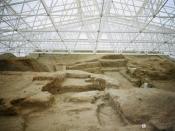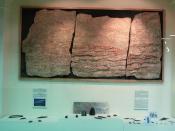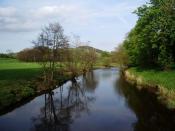Annotated Bibliography: Evidence for a goddess cult at Catal Huyuk.
Introduction and outline
Catal Hoyuk is a key site in the study of early urban centers in the Near East. The site, which dates to the Neolithic, is one of the earliest sites where evidence for early agriculture and large-scale settlement has been found. The site is 32 acres in size and was densely occupied. It has been estimated that the site supported from 1,650 to 10,000 people at one time. Current estimates for the site's population are around 5,000 people based upon the density of the houses across the site. The site is best known for its spectacular wall paintings and other art that has been uncovered within the houses. This site, dating to around 9,800 - 8,400 years ago, exhibits incredible preservation, which has led so much attention toward the site.
I will be focusing my research on this site with a particular emphasis on the female figurines that have been found at the site.
The figurines, interpreted as being religious idols for a Goddess cult, vary in size, shape and quality of design. My argument will stem from this evidence. I hope to analyse the data and come to a conclusion as to whether or not there is sufficient evidence to support the idea that a Goddess cult existed at this site.
Barstow, A.
1978The Uses of Archaeology for Women's History: James Mellaart's Work on the Neolithic Goddess at ÃÂatal Hüyük Feminist Studies 4(3): 7-17.
This article reviews some of Mellaart's interpretations of the figurines fround in his excavations at Catal Hoyuk. Approaching from a feminist perspective, the author begins by presenting the idea that perhaps the female figures were not a depiction of a cult but the the subjugation of woman in the community...



The Myth of Matriarchal Prehistory
Read The Myth of Matriarchal Prehistory: Why An Invented Past Will Not Give Women a Future by Cynthia Eller. Eller completely and thoroughly demolished the matriarchy myth (she wasn't the first). Eller has shown that wishful thinking played the biggest part of the "discovery" of this mythical matriarchy. For instance, pottery images of spirals don't denote a goddess anymore than a square design does. The images of nude women found at Catal Hyuk appear to be really nothing more than "caveman porn". The miniature booby "venus" statues were found in garbage dumps...hardly a place you'd expect to fins sacred images. Read the book for all the details.
1 out of 1 people found this comment useful.